Human Resource Management Report: Functions, Approaches, and Practices
VerifiedAdded on 2020/07/22
|16
|4260
|71
Report
AI Summary
This report delves into the core principles and practices of Human Resource Management (HRM), focusing on its critical functions within an organization. The report begins by outlining the main purpose and key functions of HRM, emphasizing its role in employee management, recruitment, selection, training, and compensation. It then explores various recruitment approaches, differentiating between internal and external methods, and evaluating their respective strengths and weaknesses. The report further examines the benefits of HRM practices for both employers and employees, highlighting how effective HRM contributes to organizational success and employee satisfaction. It also analyzes the effectiveness of different HRM practices in terms of enhancing organizational profit and productivity. The report also covers the importance of employee relations, the impact of employment legislation on decision-making, and the practical application of HRM practices in the workplace, with ALDI as a case study. Finally, the report offers a critical evaluation of the different HRM methods, practices, and approaches, providing a comprehensive understanding of HRM's role in achieving business objectives and fostering a positive work environment.
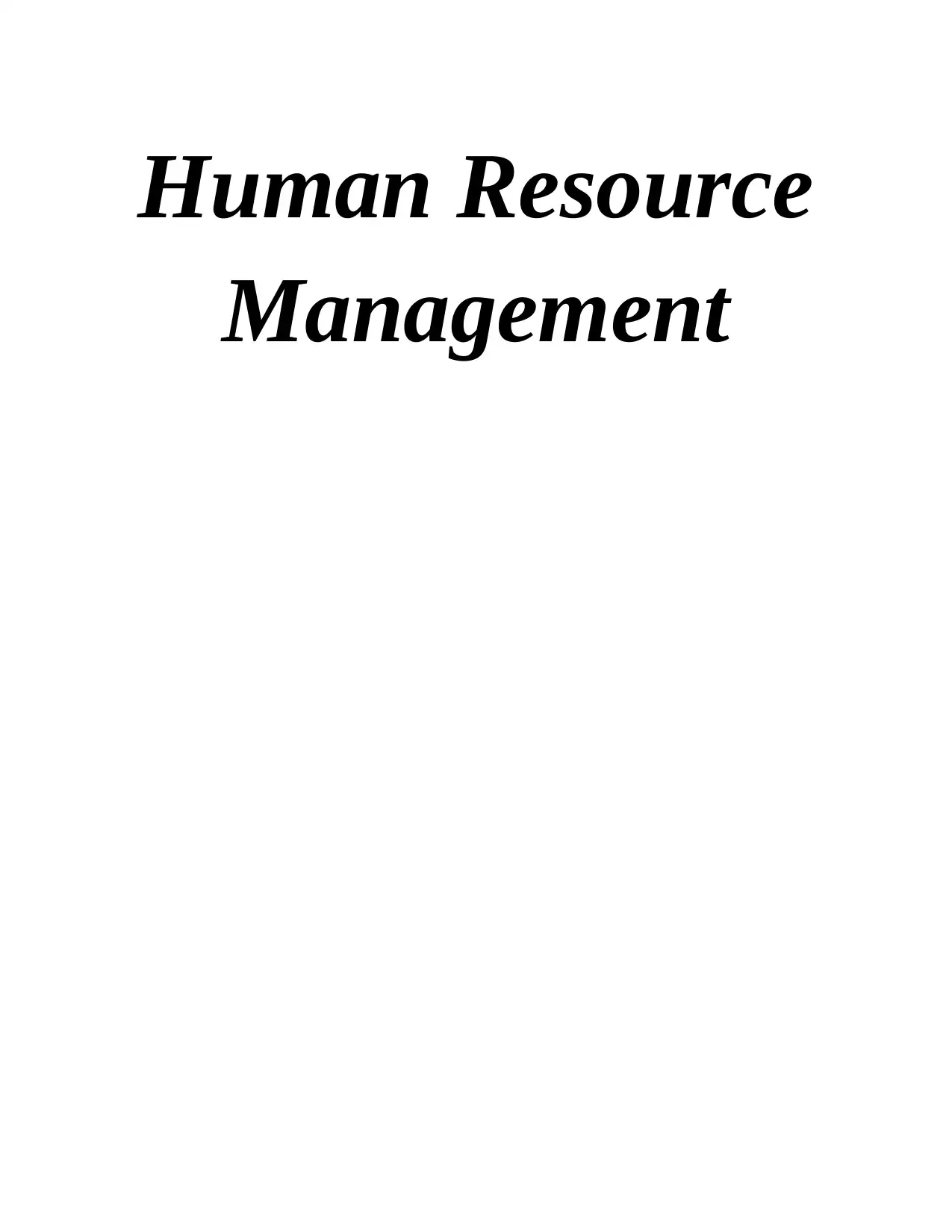
Human Resource
Management
Management
Paraphrase This Document
Need a fresh take? Get an instant paraphrase of this document with our AI Paraphraser
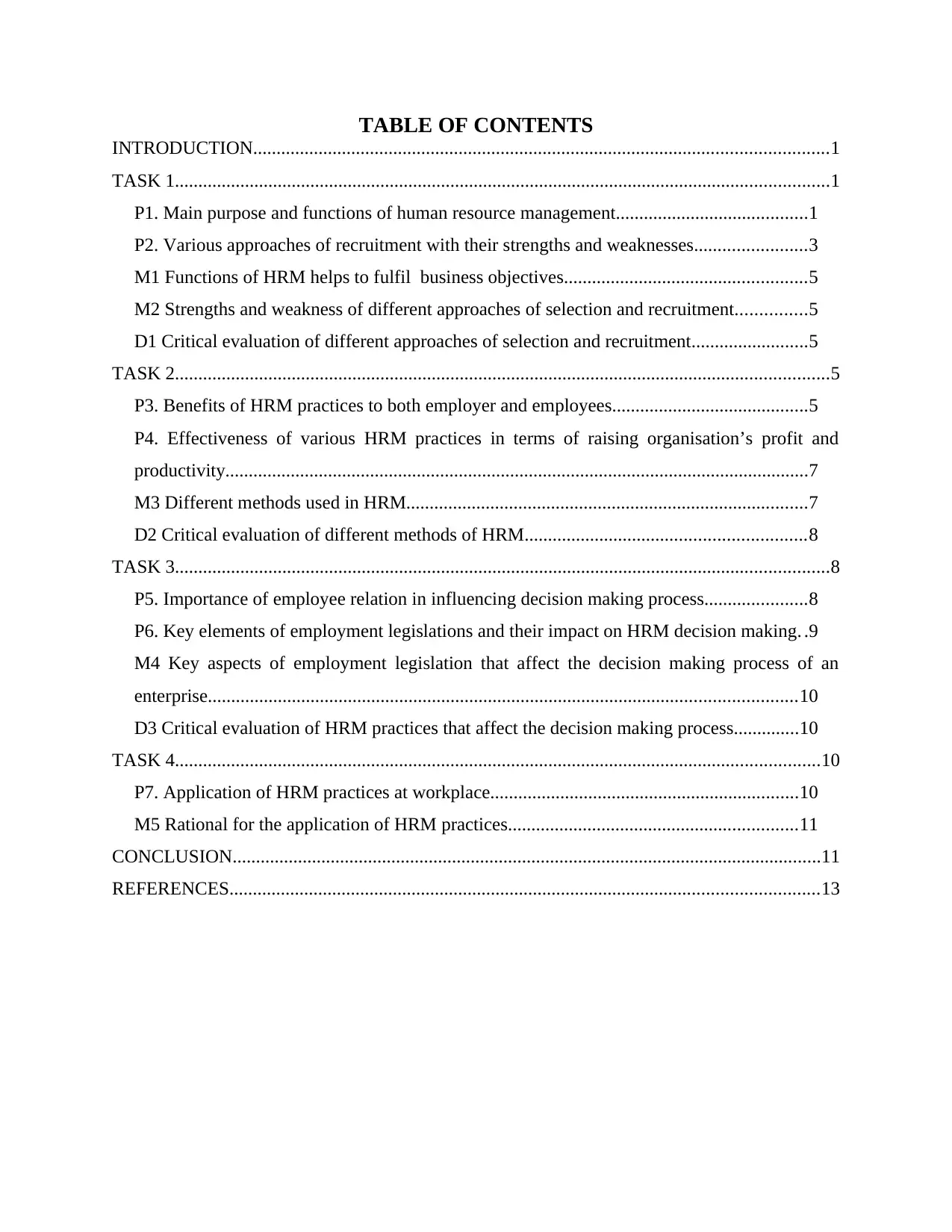
TABLE OF CONTENTS
INTRODUCTION...........................................................................................................................1
TASK 1............................................................................................................................................1
P1. Main purpose and functions of human resource management.........................................1
P2. Various approaches of recruitment with their strengths and weaknesses........................3
M1 Functions of HRM helps to fulfil business objectives....................................................5
M2 Strengths and weakness of different approaches of selection and recruitment...............5
D1 Critical evaluation of different approaches of selection and recruitment.........................5
TASK 2............................................................................................................................................5
P3. Benefits of HRM practices to both employer and employees..........................................5
P4. Effectiveness of various HRM practices in terms of raising organisation’s profit and
productivity.............................................................................................................................7
M3 Different methods used in HRM......................................................................................7
D2 Critical evaluation of different methods of HRM............................................................8
TASK 3............................................................................................................................................8
P5. Importance of employee relation in influencing decision making process......................8
P6. Key elements of employment legislations and their impact on HRM decision making. .9
M4 Key aspects of employment legislation that affect the decision making process of an
enterprise..............................................................................................................................10
D3 Critical evaluation of HRM practices that affect the decision making process..............10
TASK 4..........................................................................................................................................10
P7. Application of HRM practices at workplace..................................................................10
M5 Rational for the application of HRM practices..............................................................11
CONCLUSION..............................................................................................................................11
REFERENCES..............................................................................................................................13
INTRODUCTION...........................................................................................................................1
TASK 1............................................................................................................................................1
P1. Main purpose and functions of human resource management.........................................1
P2. Various approaches of recruitment with their strengths and weaknesses........................3
M1 Functions of HRM helps to fulfil business objectives....................................................5
M2 Strengths and weakness of different approaches of selection and recruitment...............5
D1 Critical evaluation of different approaches of selection and recruitment.........................5
TASK 2............................................................................................................................................5
P3. Benefits of HRM practices to both employer and employees..........................................5
P4. Effectiveness of various HRM practices in terms of raising organisation’s profit and
productivity.............................................................................................................................7
M3 Different methods used in HRM......................................................................................7
D2 Critical evaluation of different methods of HRM............................................................8
TASK 3............................................................................................................................................8
P5. Importance of employee relation in influencing decision making process......................8
P6. Key elements of employment legislations and their impact on HRM decision making. .9
M4 Key aspects of employment legislation that affect the decision making process of an
enterprise..............................................................................................................................10
D3 Critical evaluation of HRM practices that affect the decision making process..............10
TASK 4..........................................................................................................................................10
P7. Application of HRM practices at workplace..................................................................10
M5 Rational for the application of HRM practices..............................................................11
CONCLUSION..............................................................................................................................11
REFERENCES..............................................................................................................................13
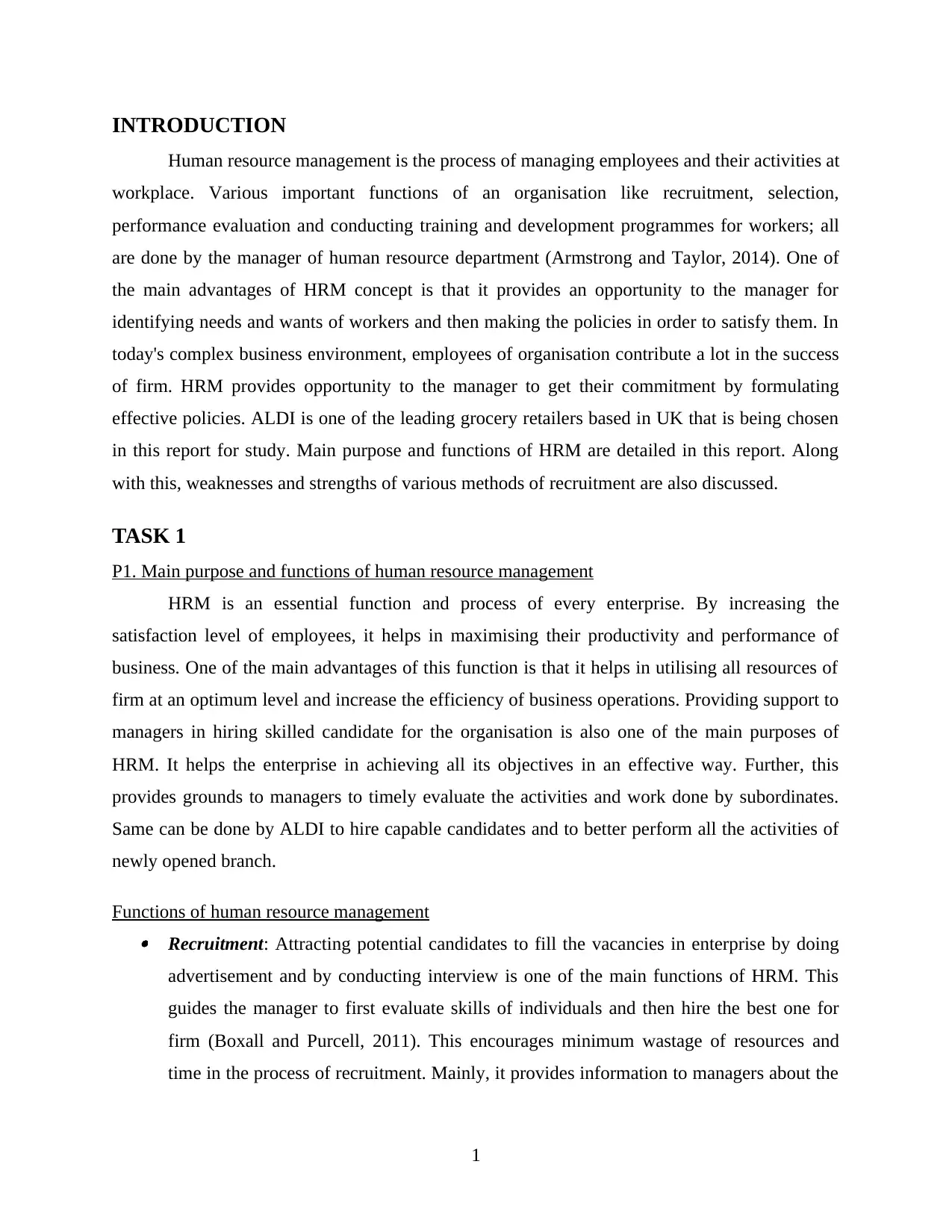
INTRODUCTION
Human resource management is the process of managing employees and their activities at
workplace. Various important functions of an organisation like recruitment, selection,
performance evaluation and conducting training and development programmes for workers; all
are done by the manager of human resource department (Armstrong and Taylor, 2014). One of
the main advantages of HRM concept is that it provides an opportunity to the manager for
identifying needs and wants of workers and then making the policies in order to satisfy them. In
today's complex business environment, employees of organisation contribute a lot in the success
of firm. HRM provides opportunity to the manager to get their commitment by formulating
effective policies. ALDI is one of the leading grocery retailers based in UK that is being chosen
in this report for study. Main purpose and functions of HRM are detailed in this report. Along
with this, weaknesses and strengths of various methods of recruitment are also discussed.
TASK 1
P1. Main purpose and functions of human resource management
HRM is an essential function and process of every enterprise. By increasing the
satisfaction level of employees, it helps in maximising their productivity and performance of
business. One of the main advantages of this function is that it helps in utilising all resources of
firm at an optimum level and increase the efficiency of business operations. Providing support to
managers in hiring skilled candidate for the organisation is also one of the main purposes of
HRM. It helps the enterprise in achieving all its objectives in an effective way. Further, this
provides grounds to managers to timely evaluate the activities and work done by subordinates.
Same can be done by ALDI to hire capable candidates and to better perform all the activities of
newly opened branch.
Functions of human resource management Recruitment: Attracting potential candidates to fill the vacancies in enterprise by doing
advertisement and by conducting interview is one of the main functions of HRM. This
guides the manager to first evaluate skills of individuals and then hire the best one for
firm (Boxall and Purcell, 2011). This encourages minimum wastage of resources and
time in the process of recruitment. Mainly, it provides information to managers about the
1
Human resource management is the process of managing employees and their activities at
workplace. Various important functions of an organisation like recruitment, selection,
performance evaluation and conducting training and development programmes for workers; all
are done by the manager of human resource department (Armstrong and Taylor, 2014). One of
the main advantages of HRM concept is that it provides an opportunity to the manager for
identifying needs and wants of workers and then making the policies in order to satisfy them. In
today's complex business environment, employees of organisation contribute a lot in the success
of firm. HRM provides opportunity to the manager to get their commitment by formulating
effective policies. ALDI is one of the leading grocery retailers based in UK that is being chosen
in this report for study. Main purpose and functions of HRM are detailed in this report. Along
with this, weaknesses and strengths of various methods of recruitment are also discussed.
TASK 1
P1. Main purpose and functions of human resource management
HRM is an essential function and process of every enterprise. By increasing the
satisfaction level of employees, it helps in maximising their productivity and performance of
business. One of the main advantages of this function is that it helps in utilising all resources of
firm at an optimum level and increase the efficiency of business operations. Providing support to
managers in hiring skilled candidate for the organisation is also one of the main purposes of
HRM. It helps the enterprise in achieving all its objectives in an effective way. Further, this
provides grounds to managers to timely evaluate the activities and work done by subordinates.
Same can be done by ALDI to hire capable candidates and to better perform all the activities of
newly opened branch.
Functions of human resource management Recruitment: Attracting potential candidates to fill the vacancies in enterprise by doing
advertisement and by conducting interview is one of the main functions of HRM. This
guides the manager to first evaluate skills of individuals and then hire the best one for
firm (Boxall and Purcell, 2011). This encourages minimum wastage of resources and
time in the process of recruitment. Mainly, it provides information to managers about the
1
⊘ This is a preview!⊘
Do you want full access?
Subscribe today to unlock all pages.

Trusted by 1+ million students worldwide
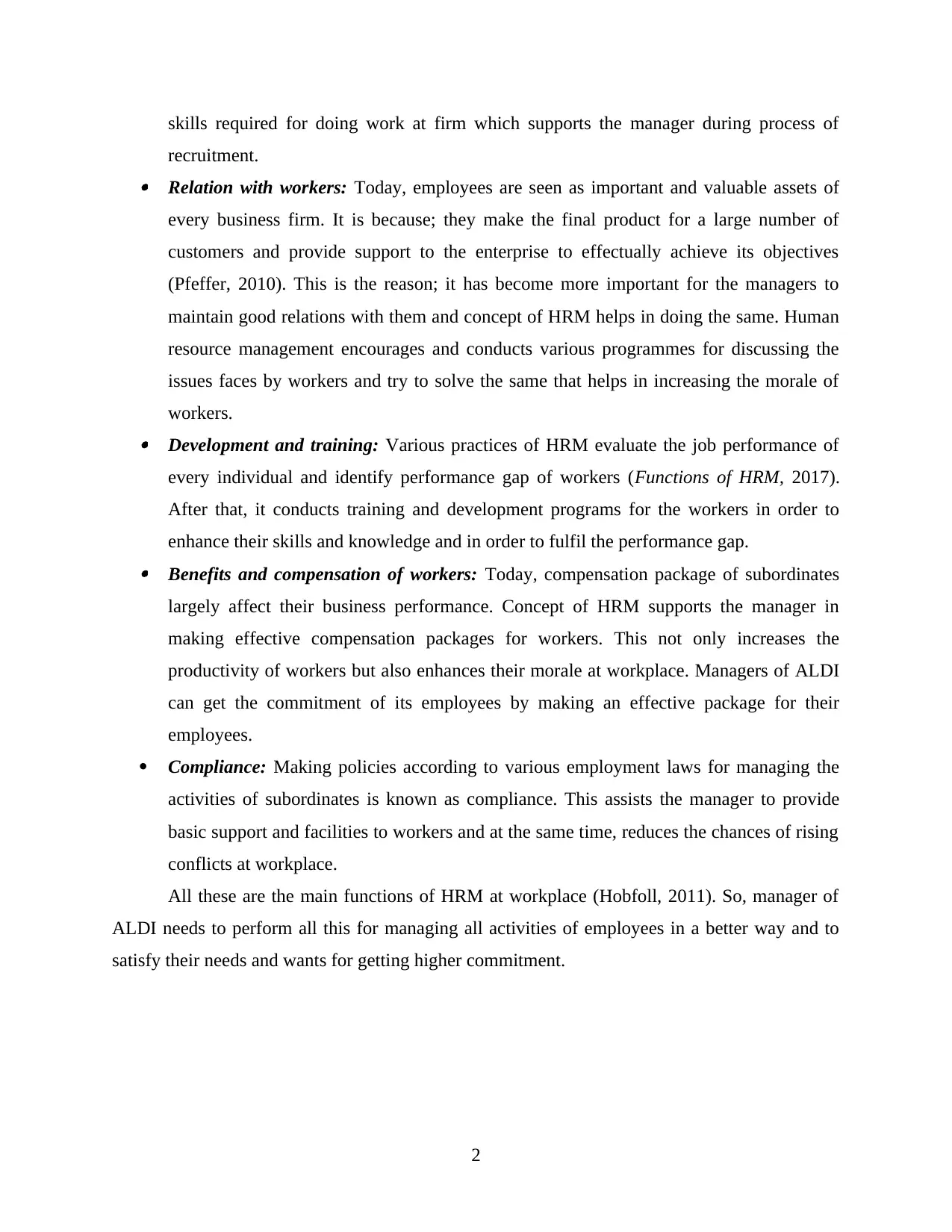
skills required for doing work at firm which supports the manager during process of
recruitment. Relation with workers: Today, employees are seen as important and valuable assets of
every business firm. It is because; they make the final product for a large number of
customers and provide support to the enterprise to effectually achieve its objectives
(Pfeffer, 2010). This is the reason; it has become more important for the managers to
maintain good relations with them and concept of HRM helps in doing the same. Human
resource management encourages and conducts various programmes for discussing the
issues faces by workers and try to solve the same that helps in increasing the morale of
workers. Development and training: Various practices of HRM evaluate the job performance of
every individual and identify performance gap of workers (Functions of HRM, 2017).
After that, it conducts training and development programs for the workers in order to
enhance their skills and knowledge and in order to fulfil the performance gap. Benefits and compensation of workers: Today, compensation package of subordinates
largely affect their business performance. Concept of HRM supports the manager in
making effective compensation packages for workers. This not only increases the
productivity of workers but also enhances their morale at workplace. Managers of ALDI
can get the commitment of its employees by making an effective package for their
employees.
Compliance: Making policies according to various employment laws for managing the
activities of subordinates is known as compliance. This assists the manager to provide
basic support and facilities to workers and at the same time, reduces the chances of rising
conflicts at workplace.
All these are the main functions of HRM at workplace (Hobfoll, 2011). So, manager of
ALDI needs to perform all this for managing all activities of employees in a better way and to
satisfy their needs and wants for getting higher commitment.
2
recruitment. Relation with workers: Today, employees are seen as important and valuable assets of
every business firm. It is because; they make the final product for a large number of
customers and provide support to the enterprise to effectually achieve its objectives
(Pfeffer, 2010). This is the reason; it has become more important for the managers to
maintain good relations with them and concept of HRM helps in doing the same. Human
resource management encourages and conducts various programmes for discussing the
issues faces by workers and try to solve the same that helps in increasing the morale of
workers. Development and training: Various practices of HRM evaluate the job performance of
every individual and identify performance gap of workers (Functions of HRM, 2017).
After that, it conducts training and development programs for the workers in order to
enhance their skills and knowledge and in order to fulfil the performance gap. Benefits and compensation of workers: Today, compensation package of subordinates
largely affect their business performance. Concept of HRM supports the manager in
making effective compensation packages for workers. This not only increases the
productivity of workers but also enhances their morale at workplace. Managers of ALDI
can get the commitment of its employees by making an effective package for their
employees.
Compliance: Making policies according to various employment laws for managing the
activities of subordinates is known as compliance. This assists the manager to provide
basic support and facilities to workers and at the same time, reduces the chances of rising
conflicts at workplace.
All these are the main functions of HRM at workplace (Hobfoll, 2011). So, manager of
ALDI needs to perform all this for managing all activities of employees in a better way and to
satisfy their needs and wants for getting higher commitment.
2
Paraphrase This Document
Need a fresh take? Get an instant paraphrase of this document with our AI Paraphraser
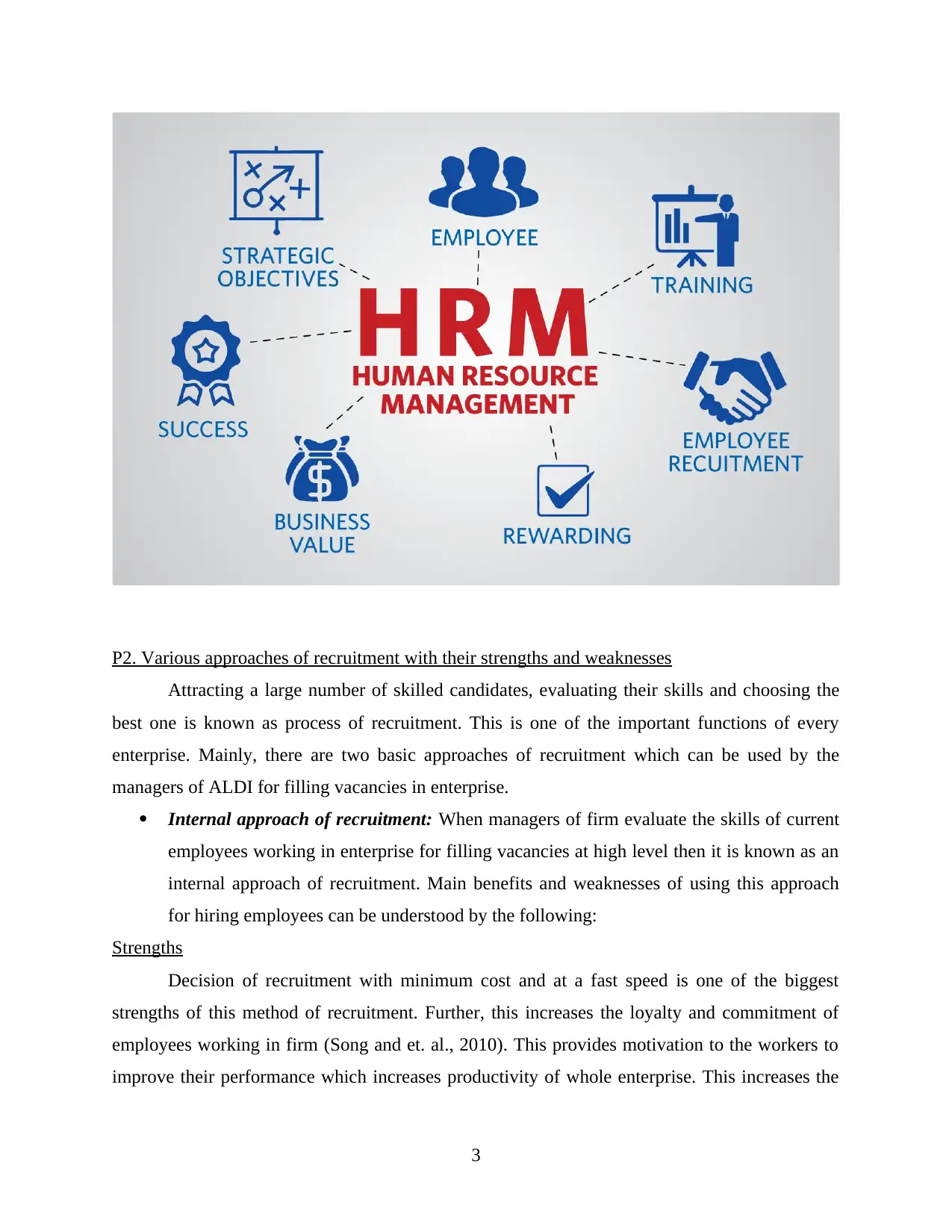
P2. Various approaches of recruitment with their strengths and weaknesses
Attracting a large number of skilled candidates, evaluating their skills and choosing the
best one is known as process of recruitment. This is one of the important functions of every
enterprise. Mainly, there are two basic approaches of recruitment which can be used by the
managers of ALDI for filling vacancies in enterprise.
Internal approach of recruitment: When managers of firm evaluate the skills of current
employees working in enterprise for filling vacancies at high level then it is known as an
internal approach of recruitment. Main benefits and weaknesses of using this approach
for hiring employees can be understood by the following:
Strengths
Decision of recruitment with minimum cost and at a fast speed is one of the biggest
strengths of this method of recruitment. Further, this increases the loyalty and commitment of
employees working in firm (Song and et. al., 2010). This provides motivation to the workers to
improve their performance which increases productivity of whole enterprise. This increases the
3
Attracting a large number of skilled candidates, evaluating their skills and choosing the
best one is known as process of recruitment. This is one of the important functions of every
enterprise. Mainly, there are two basic approaches of recruitment which can be used by the
managers of ALDI for filling vacancies in enterprise.
Internal approach of recruitment: When managers of firm evaluate the skills of current
employees working in enterprise for filling vacancies at high level then it is known as an
internal approach of recruitment. Main benefits and weaknesses of using this approach
for hiring employees can be understood by the following:
Strengths
Decision of recruitment with minimum cost and at a fast speed is one of the biggest
strengths of this method of recruitment. Further, this increases the loyalty and commitment of
employees working in firm (Song and et. al., 2010). This provides motivation to the workers to
improve their performance which increases productivity of whole enterprise. This increases the
3
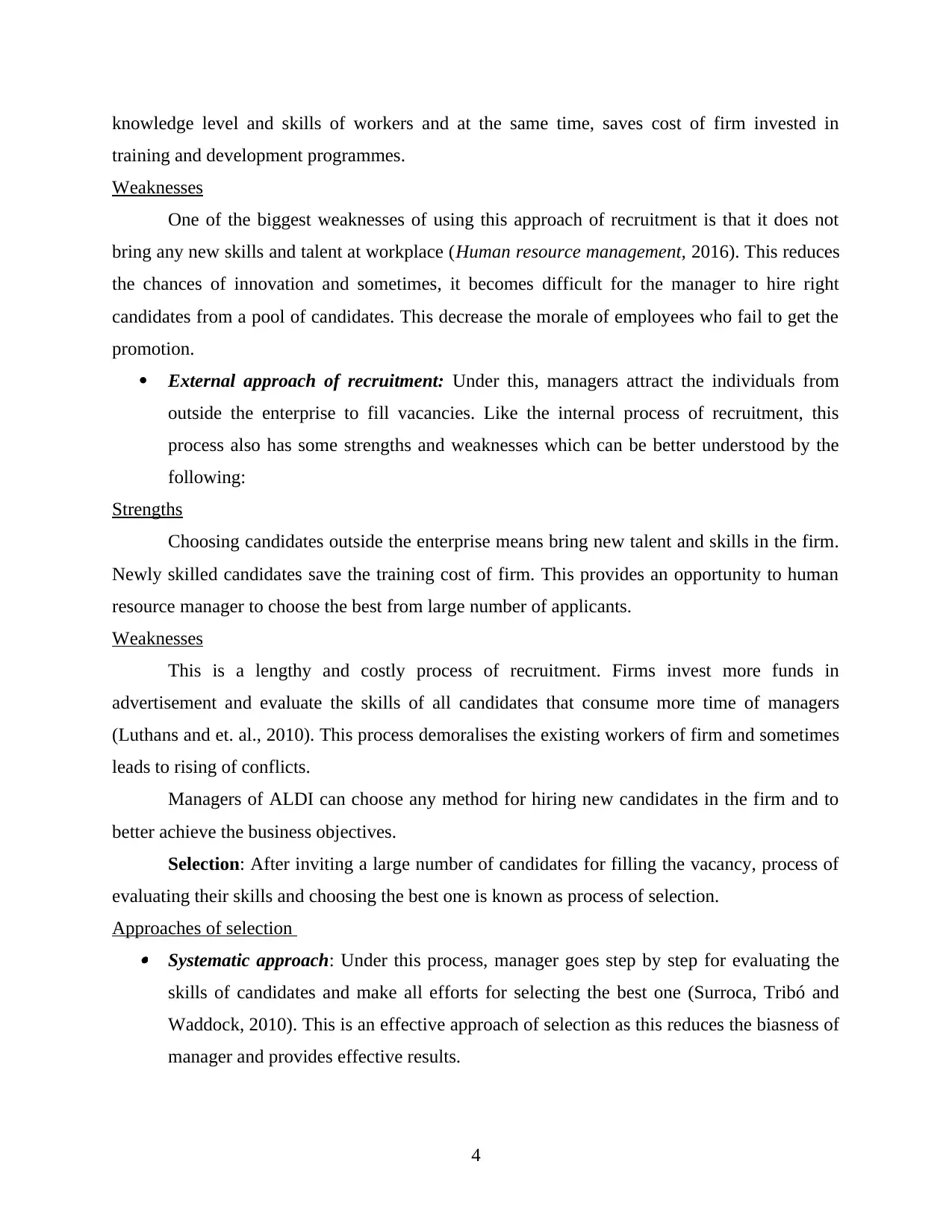
knowledge level and skills of workers and at the same time, saves cost of firm invested in
training and development programmes.
Weaknesses
One of the biggest weaknesses of using this approach of recruitment is that it does not
bring any new skills and talent at workplace (Human resource management, 2016). This reduces
the chances of innovation and sometimes, it becomes difficult for the manager to hire right
candidates from a pool of candidates. This decrease the morale of employees who fail to get the
promotion.
External approach of recruitment: Under this, managers attract the individuals from
outside the enterprise to fill vacancies. Like the internal process of recruitment, this
process also has some strengths and weaknesses which can be better understood by the
following:
Strengths
Choosing candidates outside the enterprise means bring new talent and skills in the firm.
Newly skilled candidates save the training cost of firm. This provides an opportunity to human
resource manager to choose the best from large number of applicants.
Weaknesses
This is a lengthy and costly process of recruitment. Firms invest more funds in
advertisement and evaluate the skills of all candidates that consume more time of managers
(Luthans and et. al., 2010). This process demoralises the existing workers of firm and sometimes
leads to rising of conflicts.
Managers of ALDI can choose any method for hiring new candidates in the firm and to
better achieve the business objectives.
Selection: After inviting a large number of candidates for filling the vacancy, process of
evaluating their skills and choosing the best one is known as process of selection.
Approaches of selection Systematic approach: Under this process, manager goes step by step for evaluating the
skills of candidates and make all efforts for selecting the best one (Surroca, Tribó and
Waddock, 2010). This is an effective approach of selection as this reduces the biasness of
manager and provides effective results.
4
training and development programmes.
Weaknesses
One of the biggest weaknesses of using this approach of recruitment is that it does not
bring any new skills and talent at workplace (Human resource management, 2016). This reduces
the chances of innovation and sometimes, it becomes difficult for the manager to hire right
candidates from a pool of candidates. This decrease the morale of employees who fail to get the
promotion.
External approach of recruitment: Under this, managers attract the individuals from
outside the enterprise to fill vacancies. Like the internal process of recruitment, this
process also has some strengths and weaknesses which can be better understood by the
following:
Strengths
Choosing candidates outside the enterprise means bring new talent and skills in the firm.
Newly skilled candidates save the training cost of firm. This provides an opportunity to human
resource manager to choose the best from large number of applicants.
Weaknesses
This is a lengthy and costly process of recruitment. Firms invest more funds in
advertisement and evaluate the skills of all candidates that consume more time of managers
(Luthans and et. al., 2010). This process demoralises the existing workers of firm and sometimes
leads to rising of conflicts.
Managers of ALDI can choose any method for hiring new candidates in the firm and to
better achieve the business objectives.
Selection: After inviting a large number of candidates for filling the vacancy, process of
evaluating their skills and choosing the best one is known as process of selection.
Approaches of selection Systematic approach: Under this process, manager goes step by step for evaluating the
skills of candidates and make all efforts for selecting the best one (Surroca, Tribó and
Waddock, 2010). This is an effective approach of selection as this reduces the biasness of
manager and provides effective results.
4
⊘ This is a preview!⊘
Do you want full access?
Subscribe today to unlock all pages.

Trusted by 1+ million students worldwide
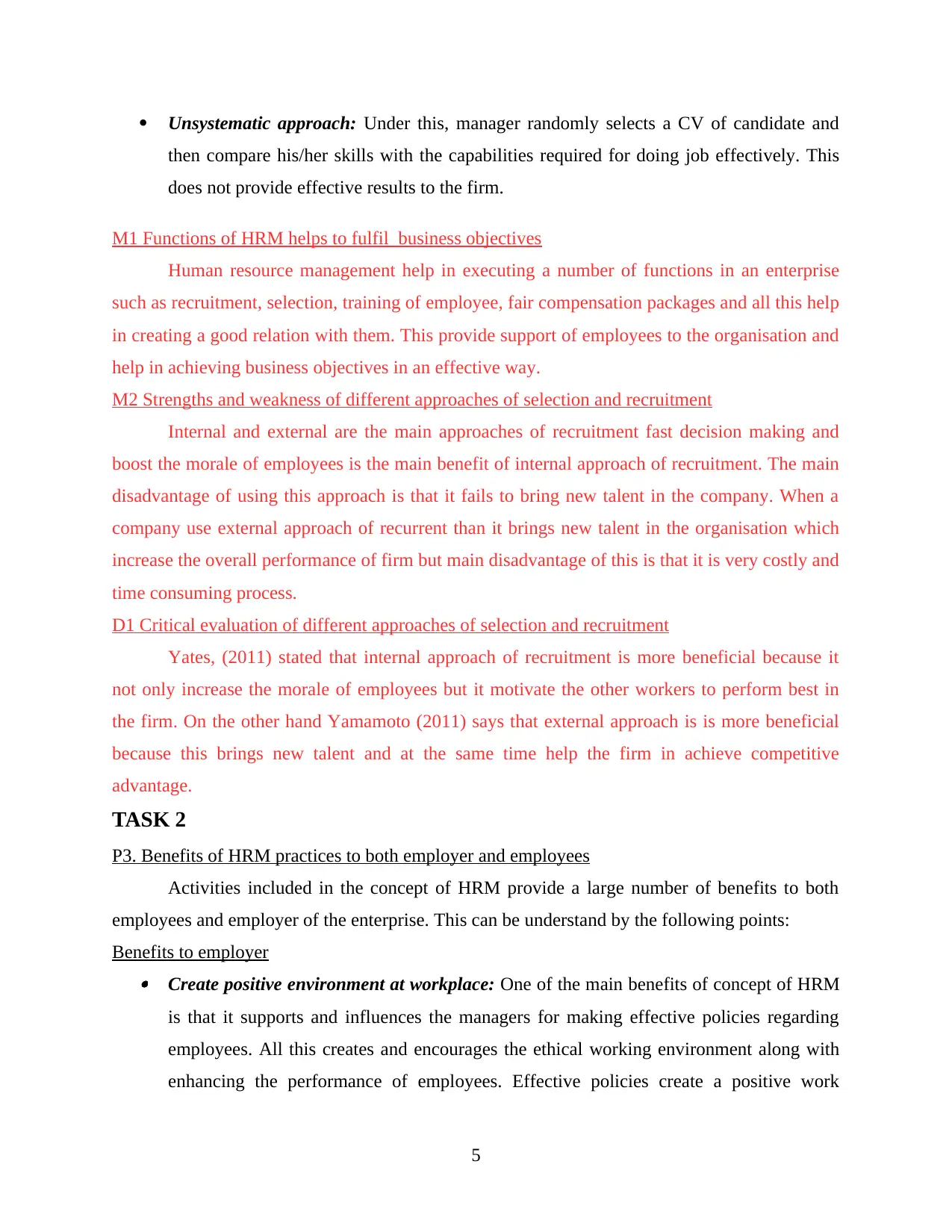
Unsystematic approach: Under this, manager randomly selects a CV of candidate and
then compare his/her skills with the capabilities required for doing job effectively. This
does not provide effective results to the firm.
M1 Functions of HRM helps to fulfil business objectives
Human resource management help in executing a number of functions in an enterprise
such as recruitment, selection, training of employee, fair compensation packages and all this help
in creating a good relation with them. This provide support of employees to the organisation and
help in achieving business objectives in an effective way.
M2 Strengths and weakness of different approaches of selection and recruitment
Internal and external are the main approaches of recruitment fast decision making and
boost the morale of employees is the main benefit of internal approach of recruitment. The main
disadvantage of using this approach is that it fails to bring new talent in the company. When a
company use external approach of recurrent than it brings new talent in the organisation which
increase the overall performance of firm but main disadvantage of this is that it is very costly and
time consuming process.
D1 Critical evaluation of different approaches of selection and recruitment
Yates, (2011) stated that internal approach of recruitment is more beneficial because it
not only increase the morale of employees but it motivate the other workers to perform best in
the firm. On the other hand Yamamoto (2011) says that external approach is is more beneficial
because this brings new talent and at the same time help the firm in achieve competitive
advantage.
TASK 2
P3. Benefits of HRM practices to both employer and employees
Activities included in the concept of HRM provide a large number of benefits to both
employees and employer of the enterprise. This can be understand by the following points:
Benefits to employer Create positive environment at workplace: One of the main benefits of concept of HRM
is that it supports and influences the managers for making effective policies regarding
employees. All this creates and encourages the ethical working environment along with
enhancing the performance of employees. Effective policies create a positive work
5
then compare his/her skills with the capabilities required for doing job effectively. This
does not provide effective results to the firm.
M1 Functions of HRM helps to fulfil business objectives
Human resource management help in executing a number of functions in an enterprise
such as recruitment, selection, training of employee, fair compensation packages and all this help
in creating a good relation with them. This provide support of employees to the organisation and
help in achieving business objectives in an effective way.
M2 Strengths and weakness of different approaches of selection and recruitment
Internal and external are the main approaches of recruitment fast decision making and
boost the morale of employees is the main benefit of internal approach of recruitment. The main
disadvantage of using this approach is that it fails to bring new talent in the company. When a
company use external approach of recurrent than it brings new talent in the organisation which
increase the overall performance of firm but main disadvantage of this is that it is very costly and
time consuming process.
D1 Critical evaluation of different approaches of selection and recruitment
Yates, (2011) stated that internal approach of recruitment is more beneficial because it
not only increase the morale of employees but it motivate the other workers to perform best in
the firm. On the other hand Yamamoto (2011) says that external approach is is more beneficial
because this brings new talent and at the same time help the firm in achieve competitive
advantage.
TASK 2
P3. Benefits of HRM practices to both employer and employees
Activities included in the concept of HRM provide a large number of benefits to both
employees and employer of the enterprise. This can be understand by the following points:
Benefits to employer Create positive environment at workplace: One of the main benefits of concept of HRM
is that it supports and influences the managers for making effective policies regarding
employees. All this creates and encourages the ethical working environment along with
enhancing the performance of employees. Effective policies create a positive work
5
Paraphrase This Document
Need a fresh take? Get an instant paraphrase of this document with our AI Paraphraser
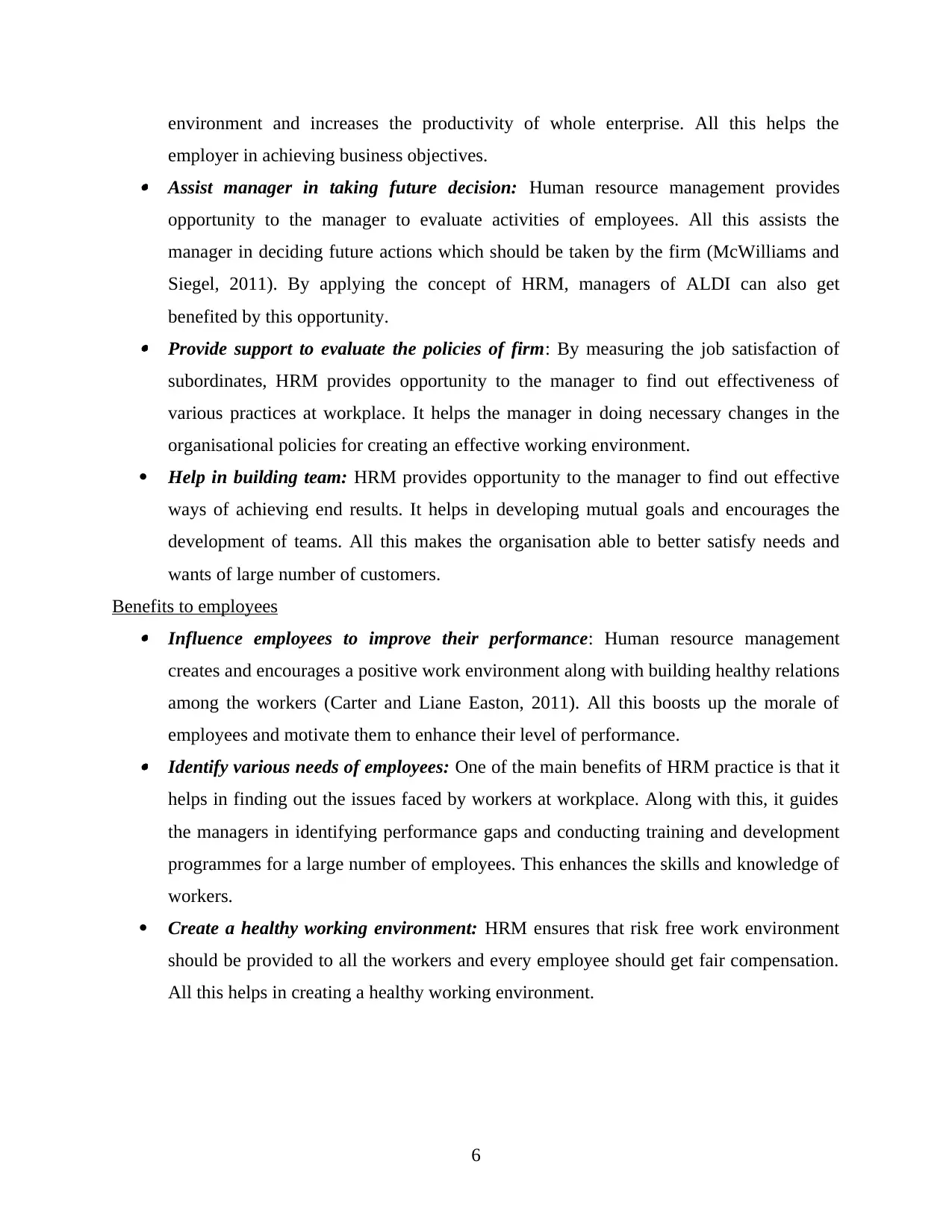
environment and increases the productivity of whole enterprise. All this helps the
employer in achieving business objectives. Assist manager in taking future decision: Human resource management provides
opportunity to the manager to evaluate activities of employees. All this assists the
manager in deciding future actions which should be taken by the firm (McWilliams and
Siegel, 2011). By applying the concept of HRM, managers of ALDI can also get
benefited by this opportunity. Provide support to evaluate the policies of firm: By measuring the job satisfaction of
subordinates, HRM provides opportunity to the manager to find out effectiveness of
various practices at workplace. It helps the manager in doing necessary changes in the
organisational policies for creating an effective working environment.
Help in building team: HRM provides opportunity to the manager to find out effective
ways of achieving end results. It helps in developing mutual goals and encourages the
development of teams. All this makes the organisation able to better satisfy needs and
wants of large number of customers.
Benefits to employees Influence employees to improve their performance: Human resource management
creates and encourages a positive work environment along with building healthy relations
among the workers (Carter and Liane Easton, 2011). All this boosts up the morale of
employees and motivate them to enhance their level of performance. Identify various needs of employees: One of the main benefits of HRM practice is that it
helps in finding out the issues faced by workers at workplace. Along with this, it guides
the managers in identifying performance gaps and conducting training and development
programmes for a large number of employees. This enhances the skills and knowledge of
workers.
Create a healthy working environment: HRM ensures that risk free work environment
should be provided to all the workers and every employee should get fair compensation.
All this helps in creating a healthy working environment.
6
employer in achieving business objectives. Assist manager in taking future decision: Human resource management provides
opportunity to the manager to evaluate activities of employees. All this assists the
manager in deciding future actions which should be taken by the firm (McWilliams and
Siegel, 2011). By applying the concept of HRM, managers of ALDI can also get
benefited by this opportunity. Provide support to evaluate the policies of firm: By measuring the job satisfaction of
subordinates, HRM provides opportunity to the manager to find out effectiveness of
various practices at workplace. It helps the manager in doing necessary changes in the
organisational policies for creating an effective working environment.
Help in building team: HRM provides opportunity to the manager to find out effective
ways of achieving end results. It helps in developing mutual goals and encourages the
development of teams. All this makes the organisation able to better satisfy needs and
wants of large number of customers.
Benefits to employees Influence employees to improve their performance: Human resource management
creates and encourages a positive work environment along with building healthy relations
among the workers (Carter and Liane Easton, 2011). All this boosts up the morale of
employees and motivate them to enhance their level of performance. Identify various needs of employees: One of the main benefits of HRM practice is that it
helps in finding out the issues faced by workers at workplace. Along with this, it guides
the managers in identifying performance gaps and conducting training and development
programmes for a large number of employees. This enhances the skills and knowledge of
workers.
Create a healthy working environment: HRM ensures that risk free work environment
should be provided to all the workers and every employee should get fair compensation.
All this helps in creating a healthy working environment.
6
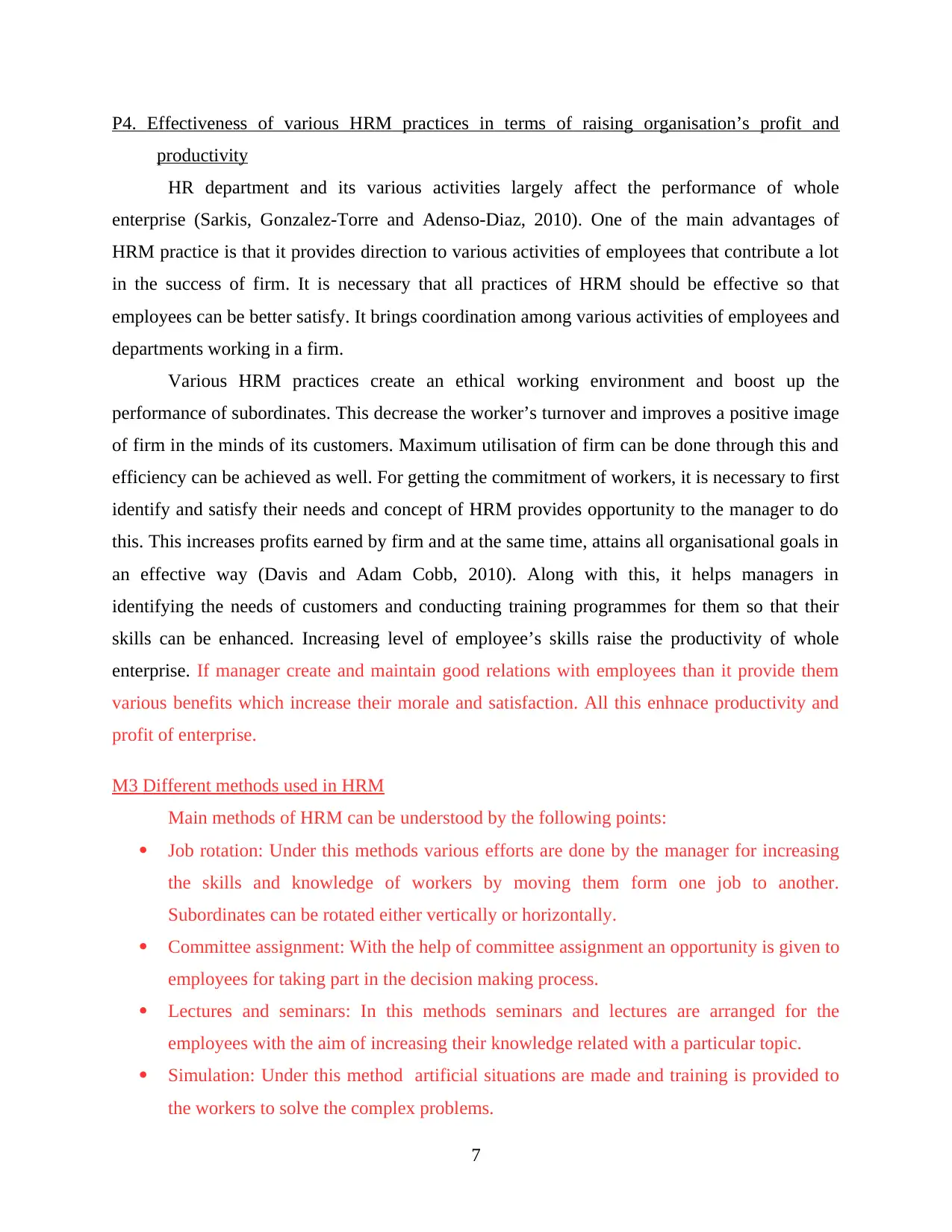
P4. Effectiveness of various HRM practices in terms of raising organisation’s profit and
productivity
HR department and its various activities largely affect the performance of whole
enterprise (Sarkis, Gonzalez-Torre and Adenso-Diaz, 2010). One of the main advantages of
HRM practice is that it provides direction to various activities of employees that contribute a lot
in the success of firm. It is necessary that all practices of HRM should be effective so that
employees can be better satisfy. It brings coordination among various activities of employees and
departments working in a firm.
Various HRM practices create an ethical working environment and boost up the
performance of subordinates. This decrease the worker’s turnover and improves a positive image
of firm in the minds of its customers. Maximum utilisation of firm can be done through this and
efficiency can be achieved as well. For getting the commitment of workers, it is necessary to first
identify and satisfy their needs and concept of HRM provides opportunity to the manager to do
this. This increases profits earned by firm and at the same time, attains all organisational goals in
an effective way (Davis and Adam Cobb, 2010). Along with this, it helps managers in
identifying the needs of customers and conducting training programmes for them so that their
skills can be enhanced. Increasing level of employee’s skills raise the productivity of whole
enterprise. If manager create and maintain good relations with employees than it provide them
various benefits which increase their morale and satisfaction. All this enhnace productivity and
profit of enterprise.
M3 Different methods used in HRM
Main methods of HRM can be understood by the following points:
Job rotation: Under this methods various efforts are done by the manager for increasing
the skills and knowledge of workers by moving them form one job to another.
Subordinates can be rotated either vertically or horizontally.
Committee assignment: With the help of committee assignment an opportunity is given to
employees for taking part in the decision making process.
Lectures and seminars: In this methods seminars and lectures are arranged for the
employees with the aim of increasing their knowledge related with a particular topic.
Simulation: Under this method artificial situations are made and training is provided to
the workers to solve the complex problems.
7
productivity
HR department and its various activities largely affect the performance of whole
enterprise (Sarkis, Gonzalez-Torre and Adenso-Diaz, 2010). One of the main advantages of
HRM practice is that it provides direction to various activities of employees that contribute a lot
in the success of firm. It is necessary that all practices of HRM should be effective so that
employees can be better satisfy. It brings coordination among various activities of employees and
departments working in a firm.
Various HRM practices create an ethical working environment and boost up the
performance of subordinates. This decrease the worker’s turnover and improves a positive image
of firm in the minds of its customers. Maximum utilisation of firm can be done through this and
efficiency can be achieved as well. For getting the commitment of workers, it is necessary to first
identify and satisfy their needs and concept of HRM provides opportunity to the manager to do
this. This increases profits earned by firm and at the same time, attains all organisational goals in
an effective way (Davis and Adam Cobb, 2010). Along with this, it helps managers in
identifying the needs of customers and conducting training programmes for them so that their
skills can be enhanced. Increasing level of employee’s skills raise the productivity of whole
enterprise. If manager create and maintain good relations with employees than it provide them
various benefits which increase their morale and satisfaction. All this enhnace productivity and
profit of enterprise.
M3 Different methods used in HRM
Main methods of HRM can be understood by the following points:
Job rotation: Under this methods various efforts are done by the manager for increasing
the skills and knowledge of workers by moving them form one job to another.
Subordinates can be rotated either vertically or horizontally.
Committee assignment: With the help of committee assignment an opportunity is given to
employees for taking part in the decision making process.
Lectures and seminars: In this methods seminars and lectures are arranged for the
employees with the aim of increasing their knowledge related with a particular topic.
Simulation: Under this method artificial situations are made and training is provided to
the workers to solve the complex problems.
7
⊘ This is a preview!⊘
Do you want full access?
Subscribe today to unlock all pages.

Trusted by 1+ million students worldwide
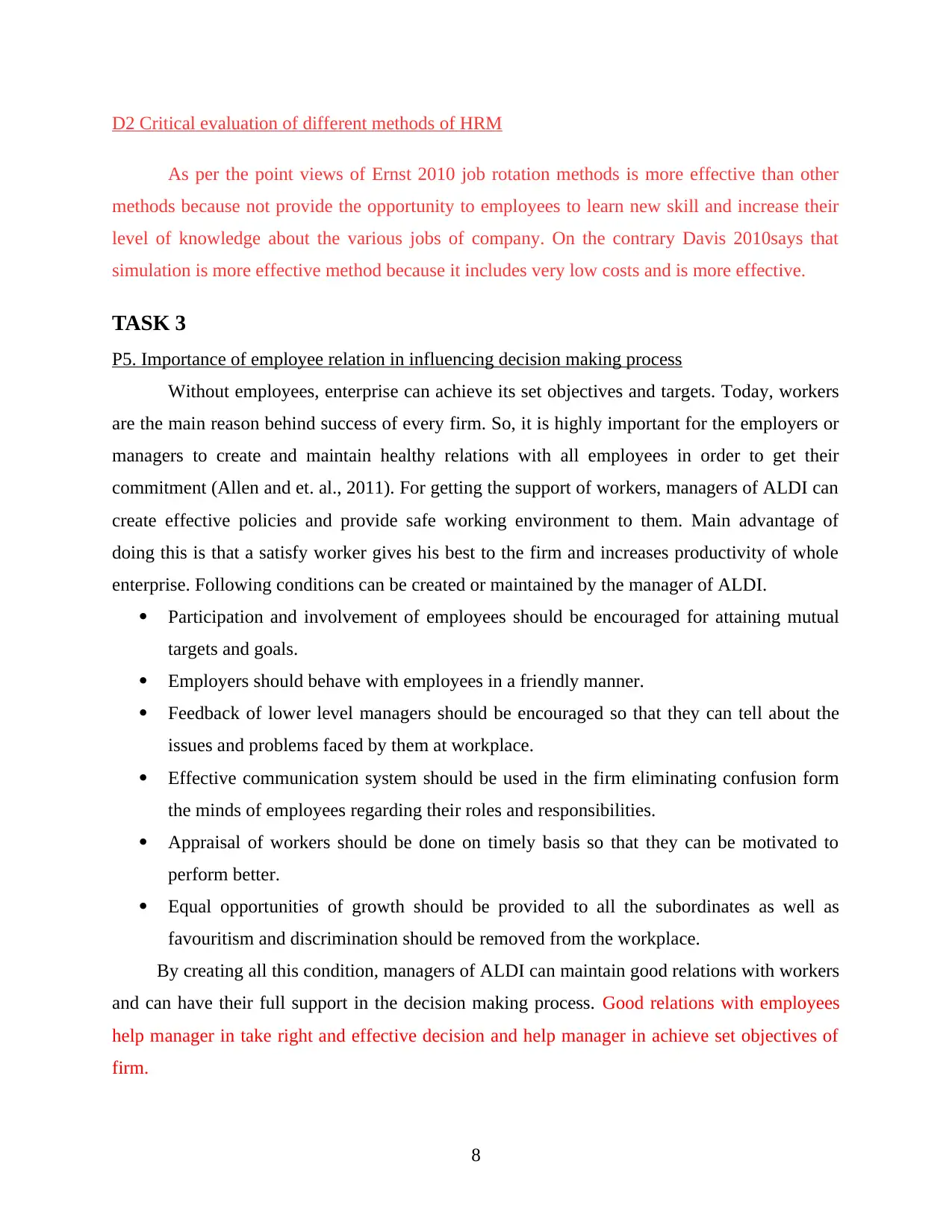
D2 Critical evaluation of different methods of HRM
As per the point views of Ernst 2010 job rotation methods is more effective than other
methods because not provide the opportunity to employees to learn new skill and increase their
level of knowledge about the various jobs of company. On the contrary Davis 2010says that
simulation is more effective method because it includes very low costs and is more effective.
TASK 3
P5. Importance of employee relation in influencing decision making process
Without employees, enterprise can achieve its set objectives and targets. Today, workers
are the main reason behind success of every firm. So, it is highly important for the employers or
managers to create and maintain healthy relations with all employees in order to get their
commitment (Allen and et. al., 2011). For getting the support of workers, managers of ALDI can
create effective policies and provide safe working environment to them. Main advantage of
doing this is that a satisfy worker gives his best to the firm and increases productivity of whole
enterprise. Following conditions can be created or maintained by the manager of ALDI.
Participation and involvement of employees should be encouraged for attaining mutual
targets and goals.
Employers should behave with employees in a friendly manner.
Feedback of lower level managers should be encouraged so that they can tell about the
issues and problems faced by them at workplace.
Effective communication system should be used in the firm eliminating confusion form
the minds of employees regarding their roles and responsibilities.
Appraisal of workers should be done on timely basis so that they can be motivated to
perform better.
Equal opportunities of growth should be provided to all the subordinates as well as
favouritism and discrimination should be removed from the workplace.
By creating all this condition, managers of ALDI can maintain good relations with workers
and can have their full support in the decision making process. Good relations with employees
help manager in take right and effective decision and help manager in achieve set objectives of
firm.
8
As per the point views of Ernst 2010 job rotation methods is more effective than other
methods because not provide the opportunity to employees to learn new skill and increase their
level of knowledge about the various jobs of company. On the contrary Davis 2010says that
simulation is more effective method because it includes very low costs and is more effective.
TASK 3
P5. Importance of employee relation in influencing decision making process
Without employees, enterprise can achieve its set objectives and targets. Today, workers
are the main reason behind success of every firm. So, it is highly important for the employers or
managers to create and maintain healthy relations with all employees in order to get their
commitment (Allen and et. al., 2011). For getting the support of workers, managers of ALDI can
create effective policies and provide safe working environment to them. Main advantage of
doing this is that a satisfy worker gives his best to the firm and increases productivity of whole
enterprise. Following conditions can be created or maintained by the manager of ALDI.
Participation and involvement of employees should be encouraged for attaining mutual
targets and goals.
Employers should behave with employees in a friendly manner.
Feedback of lower level managers should be encouraged so that they can tell about the
issues and problems faced by them at workplace.
Effective communication system should be used in the firm eliminating confusion form
the minds of employees regarding their roles and responsibilities.
Appraisal of workers should be done on timely basis so that they can be motivated to
perform better.
Equal opportunities of growth should be provided to all the subordinates as well as
favouritism and discrimination should be removed from the workplace.
By creating all this condition, managers of ALDI can maintain good relations with workers
and can have their full support in the decision making process. Good relations with employees
help manager in take right and effective decision and help manager in achieve set objectives of
firm.
8
Paraphrase This Document
Need a fresh take? Get an instant paraphrase of this document with our AI Paraphraser
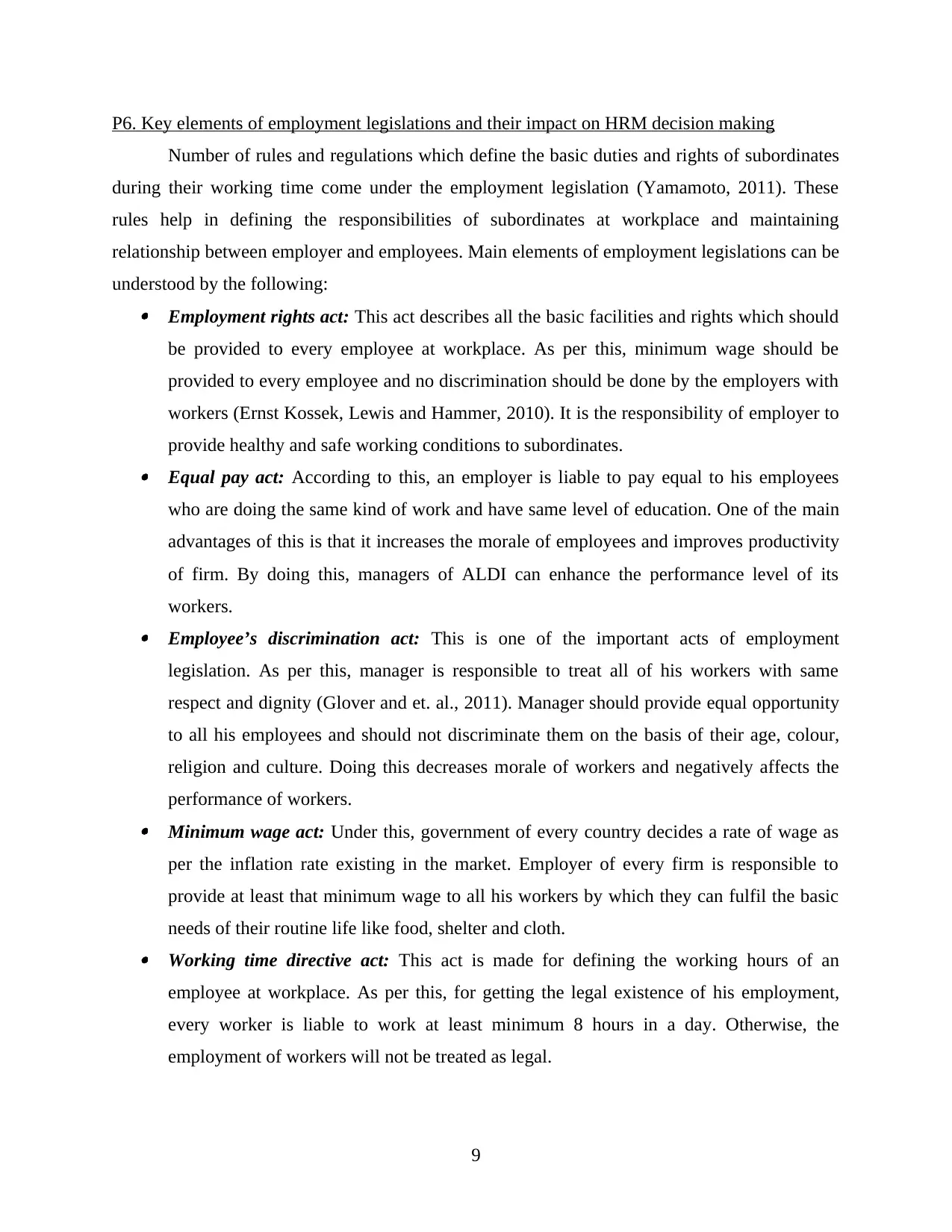
P6. Key elements of employment legislations and their impact on HRM decision making
Number of rules and regulations which define the basic duties and rights of subordinates
during their working time come under the employment legislation (Yamamoto, 2011). These
rules help in defining the responsibilities of subordinates at workplace and maintaining
relationship between employer and employees. Main elements of employment legislations can be
understood by the following: Employment rights act: This act describes all the basic facilities and rights which should
be provided to every employee at workplace. As per this, minimum wage should be
provided to every employee and no discrimination should be done by the employers with
workers (Ernst Kossek, Lewis and Hammer, 2010). It is the responsibility of employer to
provide healthy and safe working conditions to subordinates. Equal pay act: According to this, an employer is liable to pay equal to his employees
who are doing the same kind of work and have same level of education. One of the main
advantages of this is that it increases the morale of employees and improves productivity
of firm. By doing this, managers of ALDI can enhance the performance level of its
workers. Employee’s discrimination act: This is one of the important acts of employment
legislation. As per this, manager is responsible to treat all of his workers with same
respect and dignity (Glover and et. al., 2011). Manager should provide equal opportunity
to all his employees and should not discriminate them on the basis of their age, colour,
religion and culture. Doing this decreases morale of workers and negatively affects the
performance of workers. Minimum wage act: Under this, government of every country decides a rate of wage as
per the inflation rate existing in the market. Employer of every firm is responsible to
provide at least that minimum wage to all his workers by which they can fulfil the basic
needs of their routine life like food, shelter and cloth. Working time directive act: This act is made for defining the working hours of an
employee at workplace. As per this, for getting the legal existence of his employment,
every worker is liable to work at least minimum 8 hours in a day. Otherwise, the
employment of workers will not be treated as legal.
9
Number of rules and regulations which define the basic duties and rights of subordinates
during their working time come under the employment legislation (Yamamoto, 2011). These
rules help in defining the responsibilities of subordinates at workplace and maintaining
relationship between employer and employees. Main elements of employment legislations can be
understood by the following: Employment rights act: This act describes all the basic facilities and rights which should
be provided to every employee at workplace. As per this, minimum wage should be
provided to every employee and no discrimination should be done by the employers with
workers (Ernst Kossek, Lewis and Hammer, 2010). It is the responsibility of employer to
provide healthy and safe working conditions to subordinates. Equal pay act: According to this, an employer is liable to pay equal to his employees
who are doing the same kind of work and have same level of education. One of the main
advantages of this is that it increases the morale of employees and improves productivity
of firm. By doing this, managers of ALDI can enhance the performance level of its
workers. Employee’s discrimination act: This is one of the important acts of employment
legislation. As per this, manager is responsible to treat all of his workers with same
respect and dignity (Glover and et. al., 2011). Manager should provide equal opportunity
to all his employees and should not discriminate them on the basis of their age, colour,
religion and culture. Doing this decreases morale of workers and negatively affects the
performance of workers. Minimum wage act: Under this, government of every country decides a rate of wage as
per the inflation rate existing in the market. Employer of every firm is responsible to
provide at least that minimum wage to all his workers by which they can fulfil the basic
needs of their routine life like food, shelter and cloth. Working time directive act: This act is made for defining the working hours of an
employee at workplace. As per this, for getting the legal existence of his employment,
every worker is liable to work at least minimum 8 hours in a day. Otherwise, the
employment of workers will not be treated as legal.
9
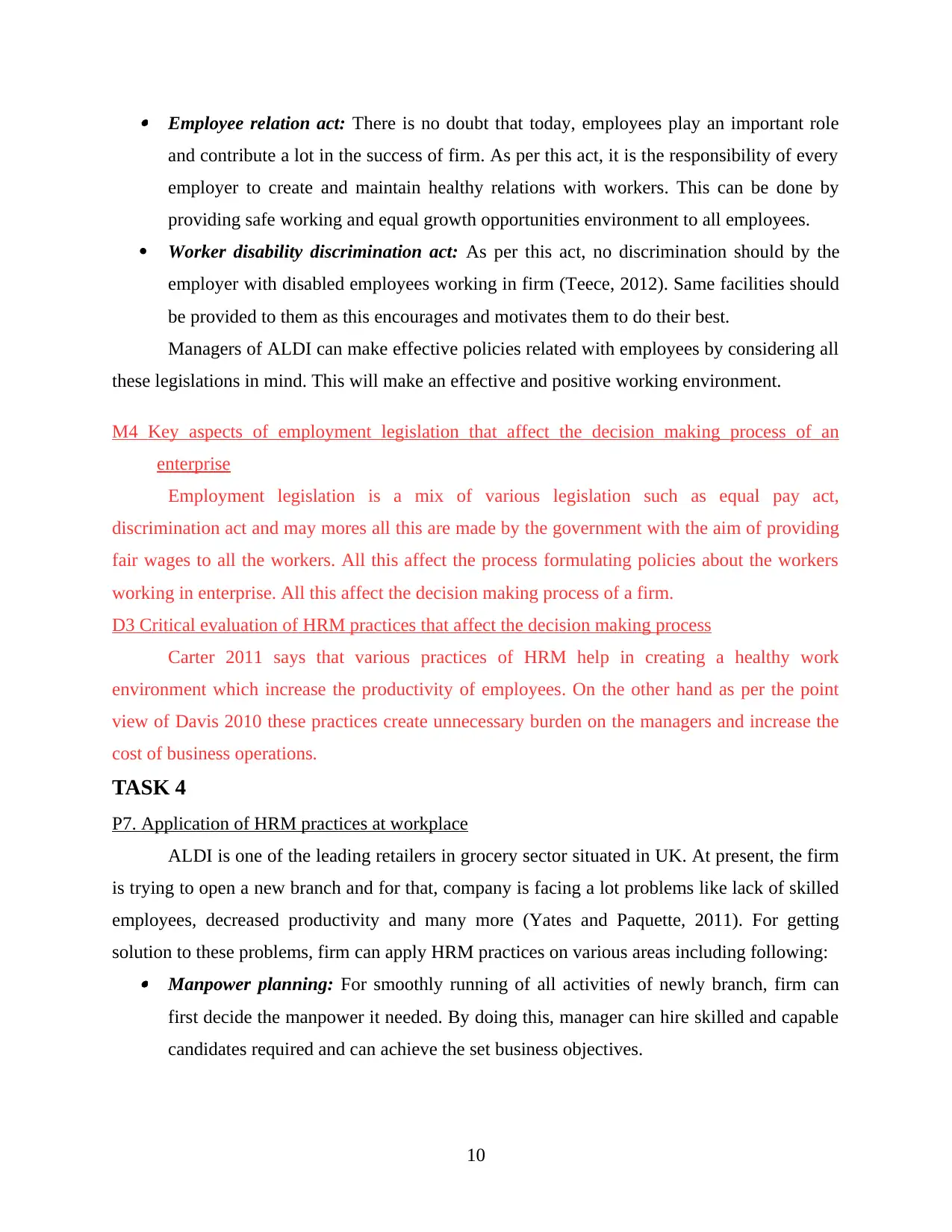
Employee relation act: There is no doubt that today, employees play an important role
and contribute a lot in the success of firm. As per this act, it is the responsibility of every
employer to create and maintain healthy relations with workers. This can be done by
providing safe working and equal growth opportunities environment to all employees.
Worker disability discrimination act: As per this act, no discrimination should by the
employer with disabled employees working in firm (Teece, 2012). Same facilities should
be provided to them as this encourages and motivates them to do their best.
Managers of ALDI can make effective policies related with employees by considering all
these legislations in mind. This will make an effective and positive working environment.
M4 Key aspects of employment legislation that affect the decision making process of an
enterprise
Employment legislation is a mix of various legislation such as equal pay act,
discrimination act and may mores all this are made by the government with the aim of providing
fair wages to all the workers. All this affect the process formulating policies about the workers
working in enterprise. All this affect the decision making process of a firm.
D3 Critical evaluation of HRM practices that affect the decision making process
Carter 2011 says that various practices of HRM help in creating a healthy work
environment which increase the productivity of employees. On the other hand as per the point
view of Davis 2010 these practices create unnecessary burden on the managers and increase the
cost of business operations.
TASK 4
P7. Application of HRM practices at workplace
ALDI is one of the leading retailers in grocery sector situated in UK. At present, the firm
is trying to open a new branch and for that, company is facing a lot problems like lack of skilled
employees, decreased productivity and many more (Yates and Paquette, 2011). For getting
solution to these problems, firm can apply HRM practices on various areas including following: Manpower planning: For smoothly running of all activities of newly branch, firm can
first decide the manpower it needed. By doing this, manager can hire skilled and capable
candidates required and can achieve the set business objectives.
10
and contribute a lot in the success of firm. As per this act, it is the responsibility of every
employer to create and maintain healthy relations with workers. This can be done by
providing safe working and equal growth opportunities environment to all employees.
Worker disability discrimination act: As per this act, no discrimination should by the
employer with disabled employees working in firm (Teece, 2012). Same facilities should
be provided to them as this encourages and motivates them to do their best.
Managers of ALDI can make effective policies related with employees by considering all
these legislations in mind. This will make an effective and positive working environment.
M4 Key aspects of employment legislation that affect the decision making process of an
enterprise
Employment legislation is a mix of various legislation such as equal pay act,
discrimination act and may mores all this are made by the government with the aim of providing
fair wages to all the workers. All this affect the process formulating policies about the workers
working in enterprise. All this affect the decision making process of a firm.
D3 Critical evaluation of HRM practices that affect the decision making process
Carter 2011 says that various practices of HRM help in creating a healthy work
environment which increase the productivity of employees. On the other hand as per the point
view of Davis 2010 these practices create unnecessary burden on the managers and increase the
cost of business operations.
TASK 4
P7. Application of HRM practices at workplace
ALDI is one of the leading retailers in grocery sector situated in UK. At present, the firm
is trying to open a new branch and for that, company is facing a lot problems like lack of skilled
employees, decreased productivity and many more (Yates and Paquette, 2011). For getting
solution to these problems, firm can apply HRM practices on various areas including following: Manpower planning: For smoothly running of all activities of newly branch, firm can
first decide the manpower it needed. By doing this, manager can hire skilled and capable
candidates required and can achieve the set business objectives.
10
⊘ This is a preview!⊘
Do you want full access?
Subscribe today to unlock all pages.

Trusted by 1+ million students worldwide
1 out of 16
Related Documents
Your All-in-One AI-Powered Toolkit for Academic Success.
+13062052269
info@desklib.com
Available 24*7 on WhatsApp / Email
![[object Object]](/_next/static/media/star-bottom.7253800d.svg)
Unlock your academic potential
Copyright © 2020–2025 A2Z Services. All Rights Reserved. Developed and managed by ZUCOL.




